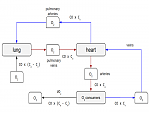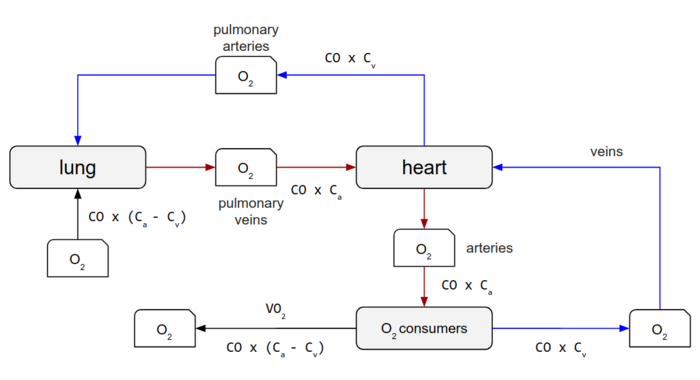25. Mai 2020
A computer scientist's diagram of heart and lung supplying the muscles with oxygen
 What happens if a computer scientist tries to understand more about the heart and lung supplying the muscles with oxygen? The computer scientists applies graph theory. Out comes the flow conservation principle, and─woosh─there’s a diagram relating cardiac output, oxygen consumption and oxygen intake.
What happens if a computer scientist tries to understand more about the heart and lung supplying the muscles with oxygen? The computer scientists applies graph theory. Out comes the flow conservation principle, and─woosh─there’s a diagram relating cardiac output, oxygen consumption and oxygen intake.
Okay, seriously, you have come to a computer scientist’s blog in order to learn about biology, are you not a little bit desparate? Possibly not, because if you are a computer scientist, mathematician, physician, anyone with a knack for network flow, or just none of the aforementioned, you might not only find the diagram entertaining but possibly also a tiny bit educational. At least drawing the diagram last weekend was educational for me.
If you are a runner, or any endurance athlete, you might be interested in getting your muscles supplied with oxygen. There’s a lot of interesting questions around that. What is involved? The lung, the heart, the muscles, at the very least. Does cardiac output matter? Yes it does. Does the ability of muscles to actually use the supplied oxygen matter? Yes, it does. How would one be able to measure oxygen consumption (VO2)? Good question. Without further ado, here’s the diagram:

- CO = cardiac output [L/s]
- Ca = relative amount of oxygen in (non-pulmonary, oxygen-rich) arterial blood [unit]
- Cv = relative amount of oxygen in (non-pulmonary, oxygen-poor) venous blood [unit]
I was trying to depict the Fick principle (ok, folks, if you know German, stop laughing), a principle that can be applied to the relationship between cardiac output and oxygen consumption; and with that we learn also something about the maximum oxygen consumption which in turn outs an upper bound on how much energy the muscles can gain through burning fuel through the oxygen system. I heard about this equation first in the online course The Science of Exercise. But if I go to Wikipedia to learn more: “oxygen consumption”, “pulmonary vein”, “intravenous cannula“─too much at once.
The diagram helped me see things clearer. The oxygen taken in by the lungs has to go somewhere. The oxygen can only enter (and some of it leave) through the lungs, so any oxygen that does not come back to the lungs must have been used (or stored?) somewhere in the body. I don’t know of any longer-term oxygen stores, but muscles use oxygen (so does the brain, and in no small amounts). Since oxygen can’t just disappear (thus flow conservation applies), all the oxygen that enters the lungs and does not leave through the lungs must have been consumed by any of the oxygen consumers (I listed muscles and brain but the definition is broad enough to incorporate my ignorance).